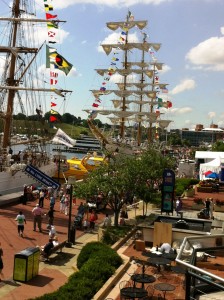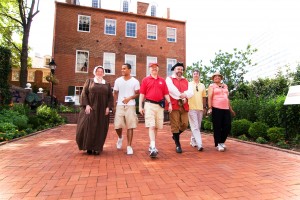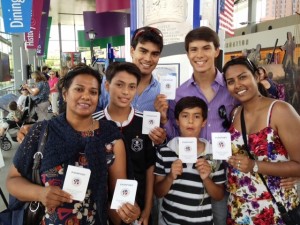By Jason Vaughan, Director of Historic Preservation and Interpretation, Baltimore Heritage Area Association, Inc.

With its heart in the city’s downtown and Inner Harbor, the Baltimore National Heritage Area boasts a rich concentration of historic, cultural, and natural resources. Certified by the state of Maryland in 2001 and designated by the U.S. Congress in 2009, the heritage area includes numerous local and National Register-listed historic districts, many of the city’s parks and open spaces, and 24 National Historic Landmarks. Three National Historic Trails cross through the city and its waterways: the Captain John Smith Chesapeake, Star-Spangled Banner, and Washington-Rochambeau Revolutionary Route. The Charles Street National Scenic Byway and the Historic National Road (designated both at the state and federal levels as scenic byways) speak to the importance of these corridors to the development of the city and to the national transportation system.
In one day a visitor to the city can stroll past modest Colonial Era residences in the waterside Fell’s Point neighborhood, see architectural gems such as Benjamin Latrobe’s Baltimore Basilica and Mies van de Rohe’s One Charles Center, and tour the home where Mary Pickersgill sewed stitches into the flag that rose above Fort McHenry and inspired the national anthem. The day is complete with a swing by the Maryland Historical Society to see the original manuscript of “The Star-Spangled Banner.”
Interpreting more than three centuries of history presents numerous challenges. In an effort to link together diverse sites and stories, the heritage area’s management entity—the non-profit Baltimore Heritage Area Association—developed an interpretive framework grouped around four primary themes under the overarching theme of “Forging an American identity.” This broad theme was inspired by Baltimore being the birthplace of the National Anthem; a center of industrial and technological change; and an important and ongoing center of civil rights activism. The four primary themes, listed below, relate to significant periods in Baltimore’s history.
• Theme One: Upholding Independence speaks to the city’s role in the War of 1812 and the Battle of Baltimore, as well as Francis Scott Key’s writing of “The Star-Spangled Banner.”
• Theme Two: Seeking Prosperity is inspired by the natural resources of the Chesapeake Bay region, the city’s colonial history, and patterns of immigration.

• Theme Three: Shaping a Monumental City looks to the city’s history as a manufacturing center and how wealthy Baltimoreans developed one of the nation’s first free public library systems and numerous philanthropic institutions.
• Theme Four: And Justice For All includes Baltimore’s Civil War and Underground Railroad history and commemorates Baltimore’s role in the fight for equality and civil rights.
A number of initiatives of the Baltimore Heritage Area Association assist with the interpretation of the four themes and the associated heritage resources. A network of trails has been developed that bring visitors to a variety of historic neighborhoods. Heritage Walk, which leads visitors from the Inner Harbor area and into the Little Italy and Historic Jonestown neighborhoods, was launched in 2003. Additional trails take visitors through the Charles Street corridor, along the Colonial Era streets of Fell’s Point, and through Old West Baltimore, Thurgood Marshall’s childhood home.

The heritage area’s Authentic Baltimore program informs travelers of uniquely Baltimore experiences for dining, shopping, and accommodations. In late fall of 2013, the heritage area will launch a new website containing virtual itineraries to Baltimore attractions, Baltimore history with special sections on African American heritage and the War of 1812, a comprehensive guide to the Charles Street National Scenic Byway, and a resource center containing information on historic preservation initiatives. The resource center will also serve as a clearinghouse for reports and inventories and provide information on the local preservation ordinance.
The heritage area’s interpretive framework and various initiatives are outlined in a comprehensive management plan, approved by the Department of the Interior in July 2013. With this newly minted plan in place, the heritage area will be in a stronger position to carry out its mission to promote, preserve, and enhance Baltimore’s cultural and historic legacy and natural resources for current and future generations.


